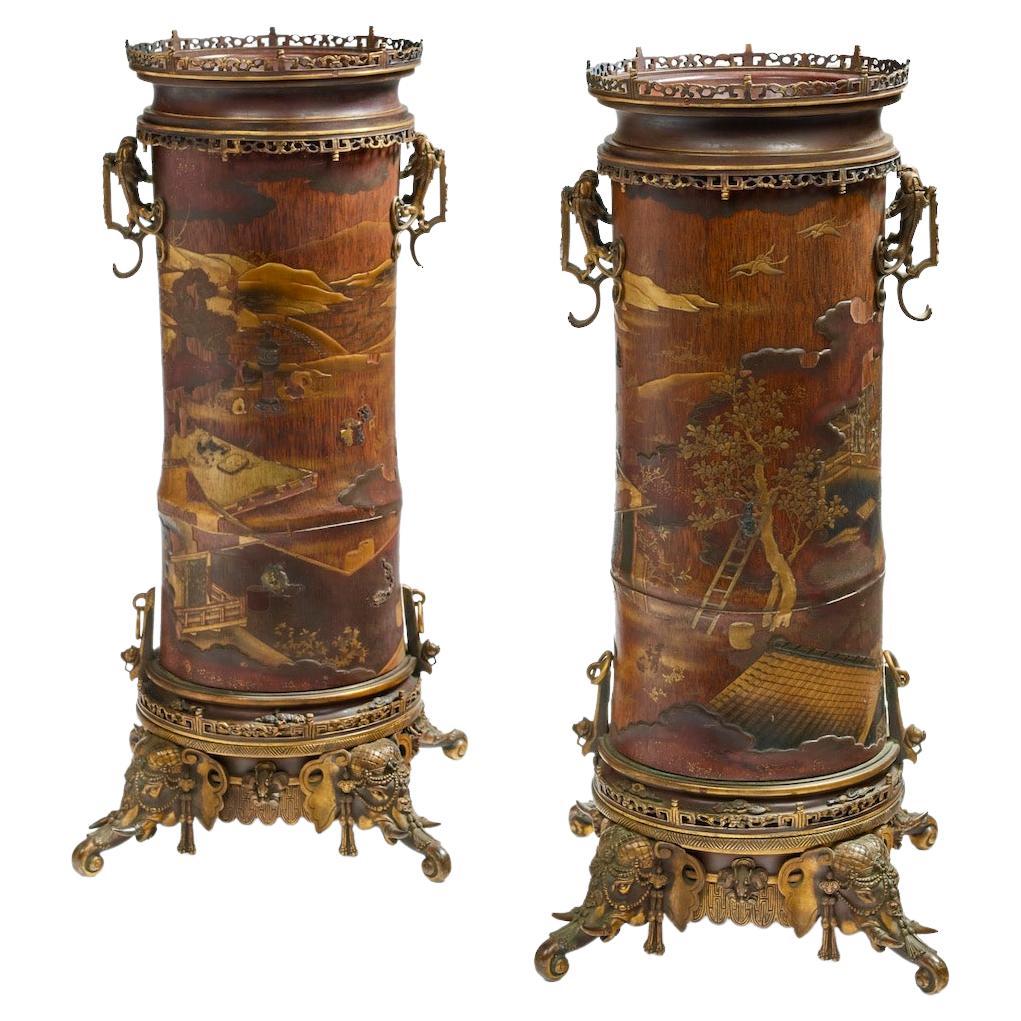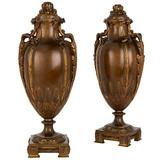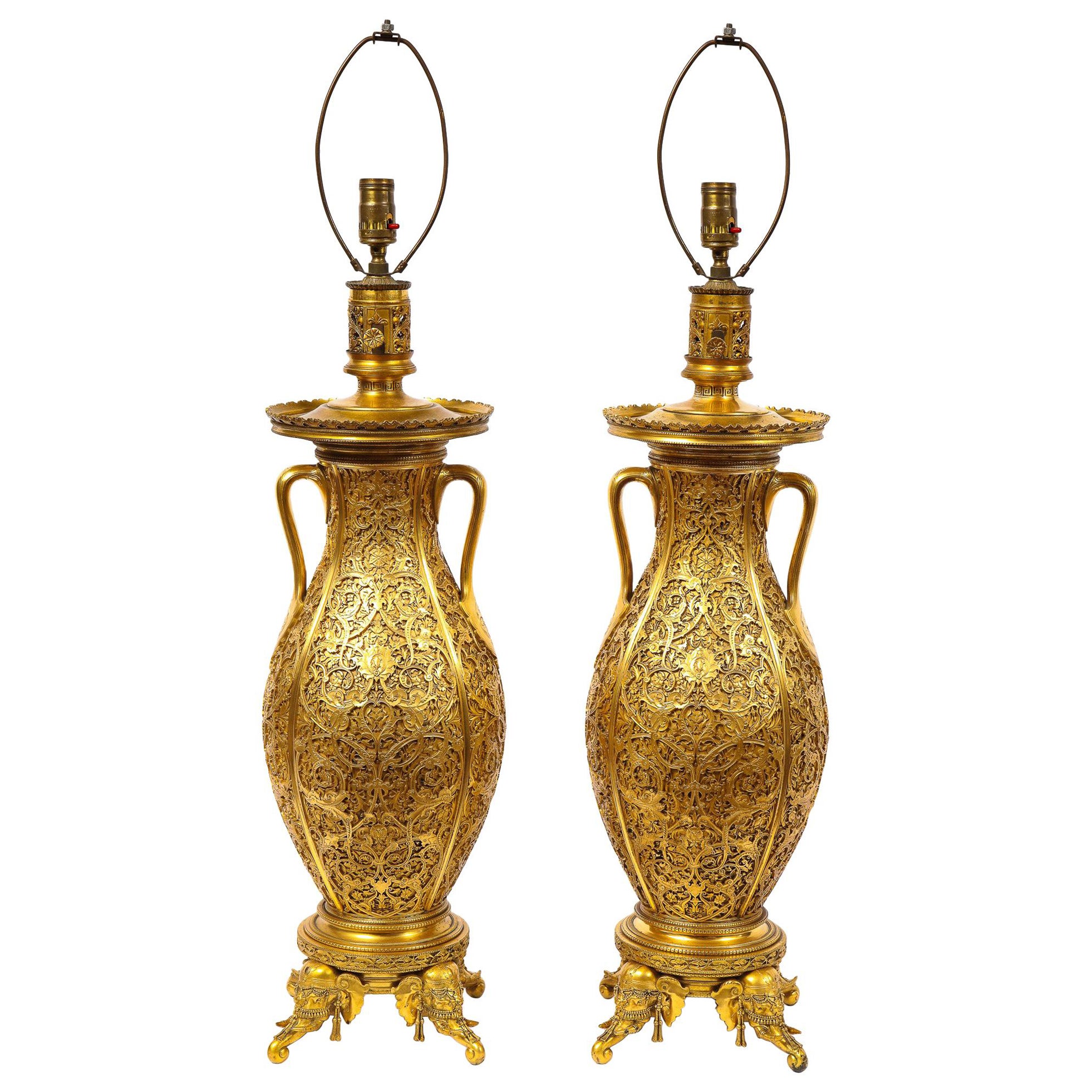Items Similar to Pair of Lacquered and Gilt Bronze Antique Japonisme Vases
Want more images or videos?
Request additional images or videos from the seller
1 of 3
Pair of Lacquered and Gilt Bronze Antique Japonisme Vases
About the Item
With an Arabesque rim and decorated with lizards, dragonflies and vines.
These unusual vases reflect the European fascination Japan at the turn of the century and delightfully incorporate lizards and dragonflies.
- Dimensions:Height: 16.93 in (43 cm)Diameter: 7.88 in (20 cm)
- Sold As:Set of 2
- Style:Japonisme (In the Style Of)
- Materials and Techniques:
- Place of Origin:
- Period:
- Date of Manufacture:c.900
- Condition:
- Seller Location:London, GB
- Reference Number:
About the Seller
5.0
Recognized Seller
These prestigious sellers are industry leaders and represent the highest echelon for item quality and design.
Gold Seller
These expertly vetted sellers are highly rated and consistently exceed customer expectations.
Established in 1975
1stDibs seller since 2012
361 sales on 1stDibs
Typical response time: 4 hours
Associations
The British Antique Dealers' AssociationInternational Confederation of Art and Antique Dealers' Associations
- ShippingRetrieving quote...Ships From: London, United Kingdom
- Return PolicyA return for this item may be initiated within 14 days of delivery.
More From This SellerView All
- Pair of Gilt and Patinated Bronze Lidded Antique VasesLocated in London, GBOf patinated bronze with gilt bronze highlights, each on a square base, the ovoid bodies decorated with ears of corn, signed 'A. Erdmann'. These impressive antique German vases...Category
Antique 19th Century German Arts and Crafts Vases
MaterialsBronze
- Large Pair of Scagliola and Gilt Bronze VasesLocated in London, GBRich, purple Scagliola and sumptuous gilt bronze combine to make these simple, chic and stylish vases, which feel as up-to-date today as they did in the 19th century when they were f...Category
Antique 19th Century French Belle Époque Vases
MaterialsBronze, Ormolu
- Pair of lapis and gilt bronze krater vasesLocated in London, GBEach krater form vase in this pair is made of gilt bronze mounted lapis lazuli. The vases stand on square gilt bronze bases which attach to the feet of the vases with acanthus leaf g...Category
20th Century French Louis XVI Vases
MaterialsLapis Lazuli, Ormolu, Bronze
- Antique pair of gilt bronze and Sèvres style porcelain cachepot vasesBy Manufacture Nationale de SèvresLocated in London, GBAntique pair of gilt bronze and Sèvres style porcelain cachepot vases French, 19th Century Height 24.5cm, width 17cm, depth 15cm...Category
Antique 19th Century French Rococo Planters, Cachepots and Jardinières
MaterialsOrmolu
- Pair of French Malachite and Gilt Bronze VasesLocated in London, GBPair of French Malachite and gilt bronze vases French, 20th century Measures: Height 63cm, width 40cm, depth 31cm Each vase in this pair is ...Category
20th Century French Louis XVI Vases
MaterialsMalachite, Ormolu
- Pair of Dresden Porcelain and Gilt Bronze VasesBy Dresden PorcelainLocated in London, GBPair of Dresden porcelain and gilt bronze vases. German, late 19th century. Measures: height 57cm, width 39cm, depth 33cm. This fine pai...Category
Antique Late 19th Century German Vases
MaterialsOrmolu
You May Also Like
- French 19th Century Pair of Lacquered Bamboos Japonisme VasesBy Edouard Lievre, Ferdinand BarbedienneLocated in Saint-Ouen, FRA 19th French century pair of Lacquered Bamboos Japonisme vases. An amazing pair of tall cylindrical bamboo vases decorated in Japanese Gold and Sil-ver Hiramaki-E Lacquer with Pavilions in The Mist and Weaving Figures, Flown Over by a Pair of Cranes. Enclosed in a Sino-Japanese Inspiration Golden and Brown Patina Bronze Mount Featuring Elephant Heads, Partially Openwork Branches and Salamanders Forming Side Handles. Circa 1870 Attributed to Édouard Lièvre (1828-1886) and Ferdinand Barbedienne (1810-1892) Édouard Lièvre (1828-1886) is one of the most talented and prolific designer and industrialist of the 19th Century, his repertoire is sometimes Sino-Japanese or Neo-Renaissance, whether in furniture or works of art, we can note in particular the parade bed of Valtesse de La Bigne, furniture commissioned by the painter Édouard Detaille or even Sarah Bernhardt, and the famous works in collaboration with Maison Christofle or those in gilded bronze and cloisonné enamel edited by Ferdinand Barbedienne, presented at the Universal Exhibitions in 1878, 1889 and 1900. He was both a draftsman, painter, illustrator, engraver, ornamentalist and cabinetmaker, first trained in the studio of the painter Thomas Couture, Lièvre was then fully immersed in the world of decoration, creation and ornamentation and provides designs for manufacturers and merchant-publishers. Often assisted by his brother Justin, he first produced works of art for his own apartment, seeking out the finest craftsmen to execute his designs for bronzes, ceramics, fabrics and luxury furniture from great virtuosity and great taste. He then collaborated with the cabinet-maker Paul Sormani, as well as haberdasher merchants such as the Escalier de Cristal, bronziers such as Maison Marnyhac and especially Ferdinand Barbedienne as on our vases with bronze mounts characteristics of Edouard Lièvre's work. Born in 1810, died in Paris in 1892, Ferdinand Barbedienne, the most important caster of bronze pieces of art during the second half of the 19th Century, created and directed in Par-is one of the major artistic foundries of his time. Barbedienne specialized in classical reproductions, whose models were exposed in famous European museums. Their illustrated catalogues included many diverse objects such as busts, ornemental sculpture (clocks, candelabras, cups) sometimes even life-sized and bronzes for furniture. Apart from his own produc-tion, Barbedienne worked for the most renowned sculptors such as Barrias, Clésinger and Carrier-Belleuse. All his works were highly esteemed and he, himself honored by contemporary critics. At the London exhibition in 1851 Barbedienne’s firm won two « Council medals ». At the 1855 Universal Exhibition, he won a medal of honor. The success of Barbedienne’s firm brought him many official commissions, such in about 1860, as Barbedienne supplied bronzes for furniture for the Pompeian Villa of Prince Napoléon-Joseph, located avenue Montaigne in Paris. At the London Universal Exhibition of 1862 Barbedienne won medals in three different categories: Furniture, Silversmith work and Artistic bronzes. Barbedienne was made an officer of the Légion d’Honneur in 1867 and Commander in 1878 when he was compared with « a prince of industry and the king of bronze casting ». His glory did not decline with the passage of the time for at the Universal Exhibition of 1889 the critics thanked Barbedienne for the example he set for other bronze-casters by the perfection of his bronzes. “Japonisme” in the second half of the 19th century, was a craze for everything that came from Japan or imitated its style. The word was first coined in a series of articles published by Philippe Burty, from May 1872 to February 1873, in the French magazine “la Renaissance Littéraire et Artistique”. Far from the Academic sphere, artists seeking for new ways of expression, appropriated this discovery. Manet and the impressionists led the way to half a century of enthusiasm for Japanese art, and largely contributed to the esthetical revolution Europe experienced between 1860 and the beginning of the twentieth century. From 1862, The World’s Fairs provoked massive arrivals of fans, kimonos, lacquers, bronzes, silks, prints and books that launched the real era of Japonisme. With those exhibitions, the demand was boosted, the number of merchants and collectors was multiplied, and artists became passionate about this new esthetic. For them, its “primitivism” was probably its most important quality: artists were fond of the Japanese art’s capacity to be close to nature and to reconcile art and society by representing, with a lot of care, the most trivial objects. In painting, Edouard Manet, Mary Cassatt, Degas, Van Gogh, Gauguin were among those who were deeply inspired by Japanese art, affected by the lack of perspective and shadow, the flat areas of strong color, the compositional freedom in placing the subject off-center, with mostly low diagonal axes to the background. The Japanese iris, peonies, bamboos, kimonos, calligraphy, fish, butterflies and other insects, the blackbirds, cranes and wading birds, the cats, tigers, and dragons were endless sources of inspiration, appropriation, and reinterpretation for European artists. The occidental productions were combining styles and artistic conceptions instead of copying Japanese art slavishly. That is what brings to light the comparison between the artworks of Kitagawa Utamaro and Degas, of Katsushika Hokusai and Van Gogh The World’s Fairs of 1851 and 1862 in London, those of 1867, 1878, 1889 and 1900 in Paris, of 1873 in Vienna and of 1904 in Saint Louis presented a number of “Japanese-Chinese” installations with earthenware, bronzes, screens and paintings and attracted the largest amounts of visitors In Vienna, the “Japanese village...Category
Antique 1870s French Japonisme Vases
MaterialsBronze
- Pair of Japanese Meiji Period Bronze and Gilt VasesBy Zo Miyao 1Located in Brighton, SussexPair of fine quality Japanese Meiji period (1868-1912) patinated bronze Miyao style gold and silver overlay two handled vases, each with twin handles, classical motif decoration with...Category
Antique Late 19th Century Japanese Japonisme Vases
MaterialsBronze
- Pair of Japonisme Porcelain and Ormolu Mounted Aesthethic Movement Vase'sLocated in Hamilton, OntarioPair of Japonism porcelain and ormolu-mounted Aesthethic Movement vase's.Category
Antique 19th Century English Japonisme Ceramics
MaterialsOrmolu, Brass
- Antique Japonisme French Baccarat Glass Bronze VaseBy BaccaratLocated in New York, NYAn antique French Baccarat glass vase with a fluted mouth. The vase is adorned with hand painted floral and foliage motifs in the Asian man...Category
Antique 19th Century French Vases
MaterialsBronze
- Pair of French Japonisme Ormolu Vases E. Lièvre, Executed by F. BarbedienneBy Edouard Lievre, Ferdinand BarbedienneLocated in New York, NYAn important and monumental pair of very fine 19th century French Japonisme/Orientalist ormolu vases designed by Edouard Lièvre and Executed by Ferdinand Barbedienne. Each body with an oval shape, finely sculpted in a floral design, fringed by orientalist style handles with cartouches, the neck surmounted by a circular pierced scrolling dragon frieze. Each vase resting on a group of four orientalist style jeweled elephant...Category
Antique 1870s French Japonisme Vases
MaterialsBronze
- Baccarat Emerald Green Pair of Japonisme Vases with Enamel Sakura Tree and SunBy BaccaratLocated in New York, NYThe bright translucent green glass vases with the spiral-fluted bellies. Enameled necks are embellished with a gilded image of the sun behind a blooming sakura tree in Japanese style...Category
Antique 19th Century French Japonisme Antiquities
MaterialsBronze, Enamel, Gold Leaf
Recently Viewed
View AllMore Ways To Browse
Gold 900
Unusual Antique Bronze
Japonisme Gold
Japanese Gilt Bronze
Dragonfly Antique
Antique Dragonfly
Japonisme Bronze
Antique Japanese Vases Pair
Pairs Japanese Bronze Vases
Pair Of Japanese Bronze Vases
Japanese Vase Lacquered
Japanese Lacquered Vase
Antique Lizard
Antique Gold Rim Vase
Bronze Dragonfly
Dragonfly Vase
Lizard Bronze
Bronze Lizard





